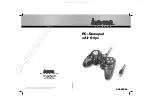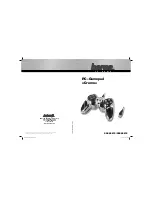
Documentation HG G-73650ZD | English, Revision 05 | Date: 09.03.2017 | www.goetting-agv.com
30
Chapter 2: Basic Principles of Track Guidance
with smooth functions (regressions over several support points) so that a controlled and
continuous movement of the vehicle is possible. The values position, accuracy, 16 free and
16 defined bits are stored for each support point.
The vehicle can be initialized between the support points. The track controller uses the in-
coming position data to identify what segment it is on and which support point follows next.
Using the current vehicle position and angle the relation to the segment is known. Then the
steering angle and vehicle velocity can be calculated.
2.6.1 Speed Calculation
The speed is obtained from the information of the segment's support points. Here the ve-
locity of the support point just passed and the upcoming support point is interpolated.
Which of the two support point velocities ("speed endpoint" or "speed connection") is se-
lected depends on whether the vehicle shall stop at the segment's end or not. If the direc-
tion of travel is reverted from forward to backward or vice versa, "speed endpoint" is select-
ed. Also, if the following segment forms a sharp bend or terminates completely, "speed
endpoint" is selected.
If an error occurs or the vehicle drives beyond the end point, the velocity is set to 0.
2.6.2 Steering Angle Calculation
The track guidance of the navigation controller is made up of two parts:
1.
The feed-forward control calculates the steering angles that keep the vehicle on the
segment, when there is no deviation to the driven segment. The steering angles
result from the vehicle's geometry and the segment. They don't have to be parame-
terized and therefore will not be explained here.
2.
The regulator to steer the vehicle back to the segment if a deviation occurs.
The combination of these two components provides the steering angle.
A distinction has to be made between omnidirectional vehicles and „normal“ vehicles, such
as trucks and forklifts. Omnidirectional vehicles are able to steer all axles independently.
These vehicles are able to drive around a curve within the possible steering angle without
having to change their orientation. This behavior offers a major advantage for the control
system: The vehicle doesn't have to move towards the direction of the segment to correct
a deviation. It can simply drive lateral to the direction of travel.
2.6.3 Guidance of an omnidirectional Vehicle
Figure 21
Guidance of an omnidirectional vehicle
Forward Dis. Fix
Forward Dis. Fix
Forward Dis. Var
Forward Dis. Var
Virtual Point Front
Direction
Target Position
Actual Position
Virtual Point Rear
Segment
Deviation Front
Deviation Rear
Direction Rear
Direction Front
Vehicle X
Vehicle Y
















































